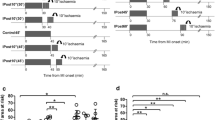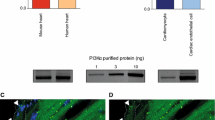Abstract
Previous studies have shown that the cardioprotective effect of ischemic preconditioning (IPC) can be mimicked pharmacologically with clinically relevant agents, including nitric oxide (NO) donors. However, whether pharmacological preconditioning shares the same molecular mechanism with IPC is not fully elucidated. The present study aimed to determine the activation of mitogen-activated protein kinases (MAPKs) (ERK1/2, p38 MAPK and p46/p54 JNKs) during ischemia and at reperfusion in nitroglycerin-induced preconditioning as compared to IPC and to correlate this with the conferred cardioprotection in anesthetized rabbits. Sixty minutes of intravenous administration of nitroglycerin was capable of inducing both early and late phase preconditioning in anesthetized rabbits, as it was expressed by the reduction of infarct size. Despite the cardioprotective effect conferred by both ischemic and nitroglycerin-induced preconditioning, there was a differential phosphorylation of MAPKs between the studied groups. p38 MAPK was activated early in ischemia in both ischemic and the early nitroglycerin-induced preconditioning while JNKs were markedly increased only after IPC. Furthermore, in these groups, ERK1/2 were activated during reperfusion. A different profile was observed in the late preconditioning induced by nitroglycerin with increased p38 MAPK and ERK1/2 phosphorylation during late ischemia. No activation of JNKs was observed at any time point in this group. It seems that activation of individual MAPK subfamilies depends on the nature of preconditioning stimulus.







Similar content being viewed by others
References
Baines CP, Pass JM, Ping P (2001) Protein kinases and kinase-modulated effects in the late phase of ischemic preconditioning. Basic Res Cardiol 96:207–218
Baxter GF, Goma FM, Yellon DM (1997) Characterisation of the infarct limiting effect of delayed preconditioning: time course and dose dependency studies in rabbit myocardium. Basic Res Cardiol 92:159–167
Baxter GF, Ferdinandy P (2001) Delayed preconditioning of myocardium: current perspectives. Basic Res Cardiol 96:329–344
Behrends M, Schulz R, Post H, Alexandrov A, Belosjorow S, Michel MC, Heusch G (2000) Inconsistent relation of MAPK activation to infarct size reduction by ischemic preconditioning in pigs. Am J Physiol 279:H1111–H1119
Bolli R, Dawn B, Tang X-L, Qiu Y, Ping P, Xuan Y-T, Jones WK, Takano H, Guo Y, Zhang J (1998) The nitric oxide hypothesis of late preconditioning. Basic Res Cardiol 93:325–338
Caroll R, Yellon DM (2000) Delayed cardioprotection in a human cardiomyocyte-derived cell line: the role of adenosine, p38MAP kinase and mitochondrial KATP. Basic Res Cardiol 95:243–249
Cohen MV, Baines CP, Downey JM (2000) Ischemic preconditioning: from adenosine receptor to KATP channel. Annu Rev Physiol 62:79–109
Dana A, Skarli M, Papakrivopoulou J, Yellon DM (2000) Adenosine A(1) receptor induced delayed preconditioning in rabbits: induction of p38 mitogen-activated protein kinase activation and Hsp27 phosphorylation via a tyrosine kinase- and protein kinase C-dependent mechanism. Circ Res 86(9):989–997
Downey JM, Cohen MV (1997) Arguments in favour of protein kinase C playing an important role in ischemic preconditioning. Basic Res Cardiol 92(Suppl 2):37–39
Downey JM, Cohen MV (2000) Do mitochondrial KATP channels serve as triggers rather than end-effectors of ischemic preconditioning’s protection? Basic Res Cardiol 95:272–274
Eisen A, Fisman EZ, Rubenfire M, Freimark D, McKechnie R, Tenenbaum A, Motro M, Adler Y (2004) Ischemic preconditioning: nearly two decades of research. A comprehensive review. Atherosclerosis 172(2):201–210
Fryer RM, Hsu AK, Gross GJ (2001) ERK and p38 MAP kinase activation are components of opioid-induced delayed cardioprotection. Basic Res Cardiol 96:136–142
Fryer RM, Patel HH, Hsu AK, Gross GJ (2001) Stress-activated protein kinase phosphorylation during cardioprotection in the ischemic myocardium. Am J Physiol 281(3):H1184–1192
Fryer RM, Pratt PF, Hsu AK, Gross GJ (2001) Differential activation of extracellular signal regulated kinase isoforms in preconditioning and opioid-induced cardioprotection. J Pharmacol Exp Ther 296:642–649
Goto M, Liu Y, Yang XM, Ardell JL, Cohen MV, Downey JM (1995) Role of bradykinin in protection of ischemic preconditioning in rabbit hearts. Circ Res 77:611–621
Gross GJ, Peart JN (2003) KATP channels and myocardial preconditioning: an update. Am J Physiol 285(3):H921–H930
Hausenloy DJ, Tsang A, Mocanu M, Yellon DM (2005) Ischemic preconditioning protects by activating prosurvival kinases at reperfusion. Am J Physiol 288:H971–H976
Heusch G (2001) Nitroglycerin and delayed preconditioning in humans. Yet another new mechanism for an old drug? Circulation 103:2876–2878
Hill M, Takano H, Tang XL, Kodani E, Shirk G, Bolli R (2001) Nitroglycerin induces late preconditioning against myocardial infarction in conscious rabbits despite development of nitrate tolerance. Circulation 104(6):694–699
Iliodromitis EK, Cokkinos P, Zoga A, Steliou I, Vrettou AR, Kremastinos DT (2003) Oral nicorandil recaptures the waned protection from preconditioning in vivo. Br J Pharmacol 138(6):1101–1106
Iliodromitis EK, Gaitanaki C, Lazou A, Bofilis E, Karavolias GK, Beis I, Kremastinos DT (2002) Dissociation of stress-activated protein kinase (p38-MAPK and JNKs) phosphorylation from the protective effect of preconditioning in vivo. J Mol Cell Cardiol 34(8):1019–1028
Lasley RD, Keith BJ, Kristo G, Yoshimura Y, Mentzer Jr RM (2005) Delayed adenosine A1 receptor preconditioning in rat myocardium is MAPK-dependent but iNOS-independent. Am J Physiol 289:H785–H791
Leesar MA, Stoddard MF, Dawn B, Jasti VG, Masden R, Bolli R (2001) Delayed preconditioning-mimetic action of nitroglycerin in patients undergoing coronary angioplasty. Circulation 103(24):2935–2941
Liu Y, Tsuchida A, Cohen MV, Downey JM (1995) Pretreatment with angiotensin II activates protein kinase C and limits myocardial infarction in isolated rabbit hearts. J Mol Cell Cardiol 27:883–892
Michel MC, Li Y, Heusch G (2001) Mitogen-activated protein kinases in the heart. Naunyn Schmiedebergs Arch Pharmacol 363(3):245–266
Murry CE, Jennings RB, Reimer KA (1986) Preconditioning with ischemia: a delay of lethal cell injury in ischemic myocardium. Circulation 74:1124–1136
Nakano A, Liu GS, Heusch G, Downey JM, Cohen MV (2000) Exogenous nitric oxide can trigger a preconditioned state through a free radical mechanism, but endogenous nitric oxide is not a trigger of classical ischemic preconditioning. J Mol Cell Cardiol 32(7):1159–1167
Ping P, Zhang J, Cao X, Li RC, Kong D, Tang X, Manchikalapudi S, Auchampach JA, Black RG, Bolli R (1999) PKC-dependent activation of p44/42 MAPKs during myocardial ischemia-reperfusion in conscious rabbits. Am J Physiol 276:H1468–H1481
Ping P, Zhang J, Huang S, Cao X, Tang XL, Li RC, Zheng YT, Qiu Y, Clerk A, Sugden P, Han J, Bolli R (1999) PKC-dependent activation of p46/p54 JNKs during ischemic preconditioning in conscious rabbits. Am J Physiol. 277:H1771–H1785
Ping P, Takano H, Zhang J, Tang XL, Qiu Y, Li RC, Banerjee S, Dawn B, Balafonova Z, Bolli R (1999) Isoform selective activation of protein kinase C by nitric oxide in the heart of conscious rabbits: a signaling mechanism for both nitric oxide- induced and ischemia-induced preconditioning. Circ Res 84:587–604
Post H, Schulz R, Behrends M, Gres P, Umschlag C, Heusch G (2000) No involvement of endogenous nitric oxide in classical preconditioning in swine. J Mol Cell Cardiol 32:725–733
Qin Q, Yang XM, Cui L, Critz SD, Cohen MV, Browner NC, Lincoln TM, Downey JM (2004) Exogenous NO triggers preconditioning via a cGMP- and mitoKATP-dependent mechanism. Am J Physiol 287:H712–H718
Schulz R, Cohen MV, Behrends M, Downey JM, Heusch G (2001) Signal transduction of ischemic preconditioning. Cardiovasc Res 52(2):181–198
Schulz R, Gres P, Skyschally A, Duschin A, Belosjorow S, Konietzka I, Heusch G (2003) Ischemic preconditioning preserves connexin 43 phosphorylation during sustained ischemia in pig hearts in vivo. FASEB J 17:1355–1357
Shinmura K, Tang XL, Takano H, Hill M, Bolli R (1999) Nitric oxide donors attenuate myocardial stunning in conscious rabbits. Am J Physiol 277:H2495–H2503
Takeishi Y, Huang Q, Wang T, Glassman M, Yoshizumi M, Baines CP, Lee JD, Kawakatsu H, Che W, Lerner-Marmarosh N, Zhang C, Yan C, Ohta S, Walsh RA, Berk BC, Abe J (2001) Src family kinase and adenosine differentially regulate multiple MAP kinases in ischemic myocardium: modulation of MAP kinases activation by ischemic preconditioning. J Mol Cell Cardiol 33(11):1989–2005
Talmor D, Applebaum A, Rudich A, Shapira Y, Tirosh A (2000) Activation of mitogen-activated protein kinases in human heart during cardiopulmonary bypass. Circ Res 86:1004–1007
Thornton JD, Liu GS, Olsson RA, Downey JM (1992) Intravenous pretreatment with A1 selective adenosine analogues protects the heart against infarction. Circulation 85:659–665
Vasara E, Seraskeris S, Lazou A (2002) Activation of α1-adrenoceptors is not essential for the mediation of ischaemic preconditioning in rat heart. Clin Exp Pharmacol Physiol 29:11–17
Wang GY, Wu S, Pei JM, Yu XC, Wong TM (2001) Kappa but not delta-opioid receptors mediate effects of ischemic preconditioning on both infarct and arrhythmia in rats. Am J Physiol 280:H384–H391
Weinbrenner C, Liu G, Cohen M, Downey J (1997) Phosphorylation of tyrosine 182 of p38 mitogen-activated protein kinase correlates with the protection of preconditioning in the rabbit heart. J Mol Cell Cardiol 29:2383–2391
Yellon DM, Downey JM (2003) Preconditioning the myocardium: from cellular physiology to clinical cardiology. Physiol Rev 83(4):1113–1151
Zhao TC, Hines DS, Kukreja RC (2001) Adenosine-induced late preconditioning in mouse hearts: role of p38 MAP kinase and mitochondrial K(ATP) channels. Am J Physiol 280(3):H1278–H1285
Zhou ZH, Peng J, Ye F, Li NS, Deng HW, Li YJ (2002) Delayed cardioprotection afforded by nitroglycerin is mediated by a-calcitonin gene related peptide. Naunyn Schmiedeberg’s Arch Pharmacol 365:253–259
Acknowledgement
This work was supported in part by a grant from the Greek Ministry of Education (PYTHAGORAS, 70/3/7399).
Author information
Authors and Affiliations
Corresponding author
Additional information
Returned for 1st revision: 18 November 2005 1st revision received: 3 January 2006
Returned for 2nd revision: 19 January 2006 2nd revision received: 6 February 2006
Returned for 3rd revision: 22 February 2006 3rd revision received: 1 March 2006
Rights and permissions
About this article
Cite this article
Iliodromitis, E.K., Gaitanaki, C., Lazou, A. et al. Differential activation of mitogen-activated protein kinases in ischemic and nitroglycerin-induced preconditioning. Basic Res Cardiol 101, 327–335 (2006). https://doi.org/10.1007/s00395-006-0594-3
Received:
Accepted:
Published:
Issue Date:
DOI: https://doi.org/10.1007/s00395-006-0594-3




